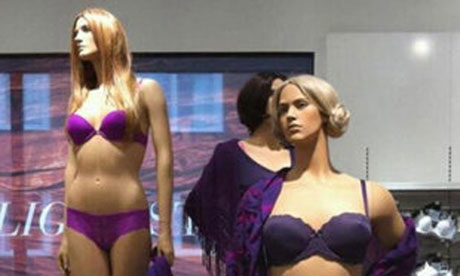The
popularity of an online photograph of larger-than-average fashion
dummies at a Swedish department store points the way for retailers to go
They are plastic, in uncomfortable poses and wearing horrible
wigs, but an army of Swedish mannequins are being held up as a shining
example of the body diversity our shops sorely need. A photograph of the
larger-than-average fashion figures from department store Åhléns went viral this month, with 63,428 people "liking" the picture on Facebook.
The picture dates back to 2010, but the photograph has touched a nerve, with commentators excitedly posting messages such as: "Isn't that just so cool? Go Sweden!"
It's not the first time that the size of dummies has made the news – back in 2007 there were calls from health experts to make the UK versions more "realistic". (Most mannequins are reported to be a size 10, but around 5ft 10in tall, while the average height for women in the UK is 5ft 4in, and size 16.) But little seemed to change on the UK high street.
Therèse Johnsson Sundberg, head of information for Åhléns, says the company has been using a range of mannequins for about 10 years. "Our customers are all different shapes so we need to reflect that in our stores. Initially they were brought in because we were starting a plus-size range, for sizes large to XXL, so we needed mannequins in different sizes. The appreciation from the customers was great, which is why we carried on."
Today the department store chain uses mannequins ranging in size from 36 to 44 (about UK size 10 to 18), and after the positive feedback of the last few weeks, is considering using them in smaller shops. And retail analyst Honor Westnedge thinks it likely that retailers in the UK will follow suit. "I have already seen mannequins styled to look older in shops," she points out.
But, she says, while it might work for retailers such as John Lewis or Marks & Spencer, it is something fashion brands focused on younger customers would be wary of. "In the young fashion market – for instance TopShop or Zara – they might be worried about pushing the boundaries too far in case they alienate their core customers. It might just not sell the clothing."
But Rebecka Silvekroon, who took and posted the photograph on her blog in 2010, is already campaigning to change their minds. After the furore this month, she has set up a website to encourage retailers to bring in different shapes. "Let us try to change the way retailers think when they are about to purchase new mannequins," she writes. "And let's try to change the way mannequins are produced by manufacturers. Simply put, let us try to change the world of fashion, one small image at a time!"
The picture dates back to 2010, but the photograph has touched a nerve, with commentators excitedly posting messages such as: "Isn't that just so cool? Go Sweden!"
It's not the first time that the size of dummies has made the news – back in 2007 there were calls from health experts to make the UK versions more "realistic". (Most mannequins are reported to be a size 10, but around 5ft 10in tall, while the average height for women in the UK is 5ft 4in, and size 16.) But little seemed to change on the UK high street.
Therèse Johnsson Sundberg, head of information for Åhléns, says the company has been using a range of mannequins for about 10 years. "Our customers are all different shapes so we need to reflect that in our stores. Initially they were brought in because we were starting a plus-size range, for sizes large to XXL, so we needed mannequins in different sizes. The appreciation from the customers was great, which is why we carried on."
Today the department store chain uses mannequins ranging in size from 36 to 44 (about UK size 10 to 18), and after the positive feedback of the last few weeks, is considering using them in smaller shops. And retail analyst Honor Westnedge thinks it likely that retailers in the UK will follow suit. "I have already seen mannequins styled to look older in shops," she points out.
But, she says, while it might work for retailers such as John Lewis or Marks & Spencer, it is something fashion brands focused on younger customers would be wary of. "In the young fashion market – for instance TopShop or Zara – they might be worried about pushing the boundaries too far in case they alienate their core customers. It might just not sell the clothing."
But Rebecka Silvekroon, who took and posted the photograph on her blog in 2010, is already campaigning to change their minds. After the furore this month, she has set up a website to encourage retailers to bring in different shapes. "Let us try to change the way retailers think when they are about to purchase new mannequins," she writes. "And let's try to change the way mannequins are produced by manufacturers. Simply put, let us try to change the world of fashion, one small image at a time!"




No comments:
Post a Comment